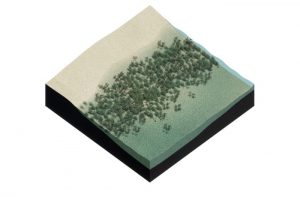Practical Applications
This section describes a practical application of the above theory. The study area for this application is East Coast Park (ECP), a recreational coastal park in Singapore. The whole park is located on reclaimed land which is subject to coastal retreat since reclamation in the 1970s. Hard structures, mainly headland breakwaters, were built to combat these erosion problems. More information on East Coast Park can be found on the page East Coast Park Design Pilot.
A Building with Nature (BwN) design was made to alleviate erosion at ECP and to enhance biodiversity in the area. Currently, ecosystems like coral reefs, seagrass meadows, oyster reefs or mangrove forests at ECP are almost or totally absent in the area. The question is to what extent a BwN design allows for restoring these ecosystems, which one would expect to occur naturally in Singapore.
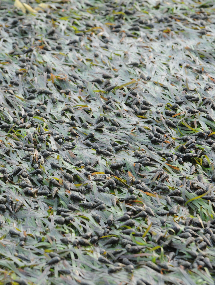
Seagreass near breakwater 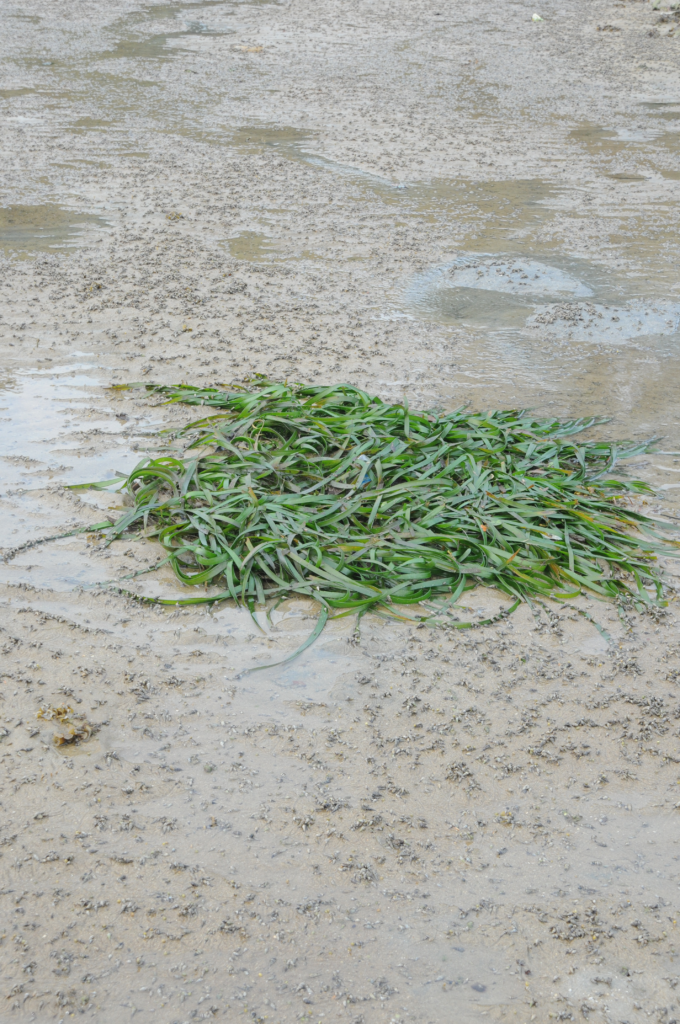
Example of patchy seagrass at ECP
Currently, seagrass is at ECP (see right figure above), is scarce. In the shelter of two low-crested breakwaters at either side of ECP, which are submerged only during high tide, seagrass occurs in patches in the intertidal zone. Apparently, since a continuous seagrass meadow is absent, the circumstances currently offered at ECP are not optimal for seagrass and hence limit expansion to a continuous meadow.
Singapore lies in a tropical environment at a latitude of 1.3 degrees north. The area is considered free from infrequent large-scale climatological effects, since tropical cyclones cannot develop this close to the equator. Tsunamis are considered unlikely due to the sheltered nature of Singapore, surrounded as it is by Sumatra, Malaysia, Borneo and the Philippines. Therefore large-scale extreme climatological events are not a limiting factor for seagrass establishment in this area.
There are no indications that pollution would hamper seagrass growth at ECP. Economical activities such as industries, shipping/harbours and run-off from densely populated areas might cause pollution. Since data on the water quality are not provided, pollution will not be considered in detail.
Determination flowchart
We will follow the determination flowchart in order to determine the reason for poor seagrass coverage at ECP. The goal is to have an indication whether it is useful to consider seagrass as an ecosystem engineer in a BwN design at ECP. At this moment a detailed design for ECP remains to be created. This provides the opportunity to adapt the design in an early stage of development, in such a way that an optimal habitat for seagrasses can be incorporated. Later on in the process, the possibilities for adaptation of the design will decrease as more aspects will have been decided on. Yet, the possibility to incorporate seagrass in the final design can be considered also in a later stage (using the flowchart).
Attributing a value to each parameter in the determination flowchart requires information on the specific project location. The following sources of information can be considered to obtain site-specific values of the parameters:
- Current state of the ecosystem at site (occurrence of species/health of species present)
- Available literature
- Computational Modelling
- Data collection (measurements/field work)
The hierarchy above is based on the amount of effort it usually takes to obtain information from the specific source. However, the effort can differ significantly according to local knowledge, access to literature, circumstances on site, availability of instruments, etc.
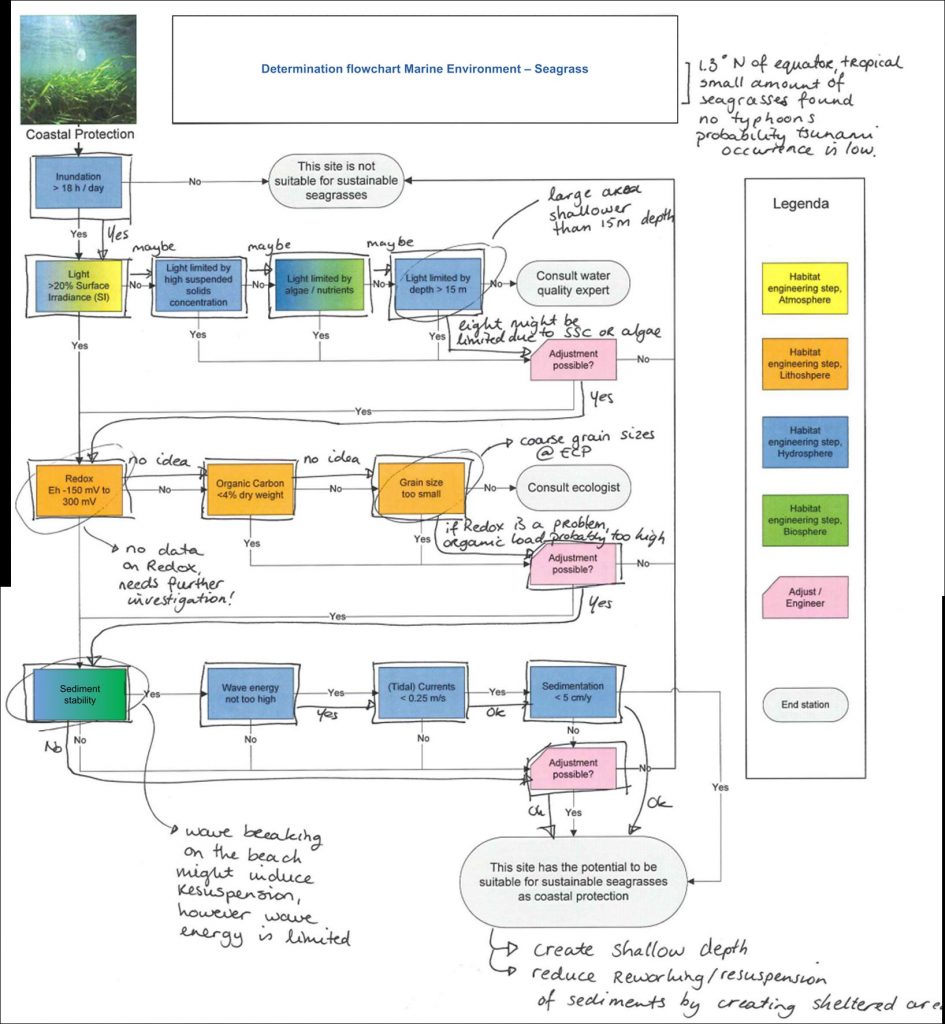
In the following section, the flowchart is discussed from top to bottom in order to outline the rationale behind each habitat requirement
Inundation – Seagrasses need to be submerged most of the time. The average tidal range in the area is 2-3m. In combination with the typical erosional beach profiles at ECP this results in an intertidal width of approximately 100 m. The upper part of the intertidal zone, between the high water springtide and high water neaptide levels, is probably too dry for seagrasses. However, the area offers a variety of inundation rates and a shallow submerged area as the seafloor slopes downwards. As seagrasses need to be submerged at least 18 hours a day and the tidal range is 3 m maximum, seagrasses can grow seaward of the MSL – 0.75 m depth contour. So inundation is not a limiting factor.
Light – The area is tropical, so surface irradiance is sufficient. Light availability at the sea bed depends on the local water depth, surface irradiance and turbidity. An initial assessment using Google Earth shows that the area is turbid. This is probably caused by erosion and resuspension of sediment by breaking waves. Google Earth pictures for different years demonstrate that the turbidity exhibits large time-variations. This could be due to seasonal effects (monsoons) and terrestrial runoff from drains that discharge suspended solids of varying origin into the coastal zone. At the Southern Islands, ~15 km southwest of Singapore, a relationship between light availability and water depth has been derived. Assuming applicability of this relationship to ECP, seagrass should be able to grow above MSL – 3 m. In the absence of detailed data for ECP the habitat engineering steps in relation to light shall be followed.
Suspended solids – Turbidity caused by suspended solids could be limiting for the further expansion of seagrasses, considering that seagrasses are present only in the intertidal zone behind the breakwaters. Suspended solids can originate from resuspension by hydrodynamic energy, dredging plumes, navigation in shallow water and terrestrial run-off. Turbidity in the sheltered area behind the breakwater might be lower. In the intertidal zone, the leaves do receive enough light, but as they go deeper light penetration quickly decreases and becomes limiting. If the seagrasses expand further landwards, the inundation levels become critical. In conclusion, limited light penetration due to high turbidity could be one of the limiting factors for seagrass establishment, especially seaward of the intertidal zone.
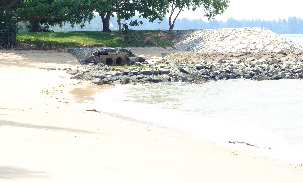
Small drain at ECP 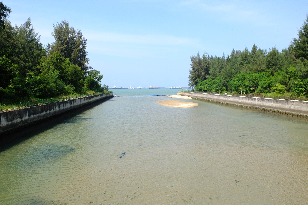
Large drain at ECP
Nutrients/algae – As described above, light could be limited by turbidity. The turbidity can be a combination of suspended solids and phytoplankton. Phytoplankton growth absorbs light, oxygen and nutrients. The terrestrial runoff, entering the coastal zone via the drains present at ECP (see figures above) can contain organic matter and nutrients. Another possible source of nutrients is fresh water from the sewage system, which is filtered and released into the sea at Changi (5 km from the water line at the sea bed). Nutrients can stimulate phytoplankton growth which can result in increased turbidity in the water column and in competition for light as phytoplankton absorbs light for photosynthesis. In addition, epiphytes (see Biosphere) can create a thin layer on the seagrass leave, further reducing light availability for the seagrasses. In conclusion, there is an indication that the growth of algae can be a problem at ECP, because there are a lot of drains which may discharge large amounts of nutrients.
Depth – Depth is not thought a limiting factor for the expansion of seagrasses as the area offers enough space above the 15 m depth contour. The area suitable for seagrass given light and inundation levels is assumed to be between MSL -0.75 m and MSL -3 m.
Adjustment of light availability possible? – There are indications that light limits the seaward expansion/growth of seagrasses at ECP due to a combination of suspended solids and/or phytoplankton. This can be verified by collecting water quality data and studying the existing seagrass plants at ECP (to check if they are covered with epiphytes). Possibilities to engineer the light availability include: decreasing the nutrient load and – by reducing the hydrodynamic energy – resuspension and suspended sediment concentration. When reducing the hydrodynamic energy, it has to be assured that the sedimentation rate becomes not too high, because seagrasses cannot withstand a too high sedimentation rate. This is explained later on in the sedimentation paragraph. Another option is to locate the sea grass meadow in a relatively shallow inundated area.
Redox potential – No measurements or literature of the sediment redox potential are available. Since this parameter is unknown, the habitat engineering steps in relation to the lithosphere shall be elaborated.
Organic carbon & Sediment type – No measurements are present on the organic content in the sediment bed, but some basic information on sediment grain sizes is available. Since the ECP coastline is a reclaimed area, two types of sediments can be found: the sandy material which is used for the reclamation, and the original material, which consists of clayey and silt deposits. The beach and intertidal zone mainly consist of sand with a grain size of circa 600 µm. The sediment type used for reclamation is not considered to have a high organic load as it originates from sand deposits poor of organic material. Organic carbon supplied by the drains can consume oxygen and result in anoxic conditions. It is important to consider the flux of organic load instead of the concentrations, because high flux of low concentrations can still result in low oxygen content. If light is sufficient, seagrasses can produce oxygen and make the soil less anoxic. Accumulation of organic carbon (for example supplied by the drains) in the coarse- grained material is unlikely, because larger grains allow for a higher exchange between the pores and the overlying water column. In addition, the size allows for a higher oxygen penetration which prevents or reduces toxic sulphide (S2-) formation. The original marine clay deposits, which form the sea bed further offshore, are fine-grained and can be anoxic due to low oxygen penetration. The organic carbon content of the nourished material is therefore assumed to be negligible, whereas additional data are needed in order to find out whether the supply of organic carbon via drains is an issue.
Adjustment of soil characteristics possible? – Both high organic carbon content and small grain size can promote a too low redox potential (i.e. promote anoxic conditions and sulphide formation). At this moment, we have little information that these factors are influencing the redox potential in a negative way. Especially at the beach and in the intertidal zone, the substrate seems to be suitable. Further offshore the indigenous material needs further investigation to determine the suitability for seagrass growth, especially when light availability at these locations is suitable.
Sediment stability – One of the problems at ECP is erosion of the beach. This is most likely caused by a combination of resuspension of sediment by waves and transport by tidal currents. Top layer disturbance could be an issue, especially above the 3 m depth contour, where waves are acting on the seabed. This indicates the need for further exploration of the habitat engineering steps in relation to the hydrodynamics. Another potential limiting factor for seagrass establishment could be the slope of the seabed, as steeper slopes reduce sediment stability and make the location less suitable for seagrass establishment and growth. Burrowers like crabs and worms are present at ECP, but there is no information on whether they cause so much top layer disturbance that they prevent establishment. Further bioturbation could be caused by bottom-dwelling fish, but further research is needed to determine to what extent fish might prevent seagrass growth. In summary, sediment instability could be a challenge for seagrasses to establish and/or expand.
Wave energy – The wave climate is very moderate at ECP, with waves lower than 1 m wave height and a period of approximately 6 s. Due to the concave beach profile wave energy is concentrated in a narrow zone and wave breaking occurs at the water line (see figure below). Due to the tidal water level variation, the active zone extends between the high water line and the 3 m depth contour. This might limit the establishment of sea grass in that zone, as it also increases the top layer disturbance (see above). Since ECP is a reclaimed area, the relation between grain size and hydrodynamic energy is disturbed. The grain size is not a good indicator of hydrodynamic energy: relatively coarse sediment is present, whereas the hydrodynamic energy is low.
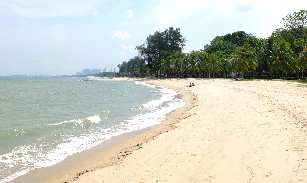
Tidal Currents – Model results indicate that the tidal currents down to the 3 m depth contour are less than 0.25 m/s. Tidal velocities increase with water depth, hence these velocities offshore the 3 m depth contour exceed the limit. In the system description of the East Coast Park Design Pilot more information on the tide and wave climate can be found. As light availability seaward of the 3 m depth contour might become critical, tidal currents are not assumed to be the only limiting factor seaward of the 3 m depth contour.
Sedimentation – The coast of ECP is subject to erosion. Sedimentation can prevent seagrass establishment, if eroded sediment is (temporarily) settling on young seagrass. This is closely related to toplayer disturbance and sediment stalibity.
Conclusion
This initial assessment shows that a combination of factors influence the habitat in such a way that seagrass is currently absent in the central part of ECP. To fulfill the inundation requirement seagrasses can only establish seaward of the 0.75m depth contour. Light availability in combination with the tidal currents requirement make the area seaward of the 3 m depth contour less suitable for seagrass establishment. High top layer disturbance due to hydrodynamic energy (and maybe also bioturbation) are a problem in the area between the 0.75 m and the 3 m depth contour. A strong indication that the hydrodynamics are playing a role at ECP is the fact that seagrass does occur at locations which are sheltered by shore-parallel breakwaters. The breakwaters limit hydrodynamic energy, especially when they are emerged during low water. The steep seabed slope contributes to sediment instability.
Implications of this assessment for a BwN design which includes seagrass as an ecosystem engineer are:
- Adjust the bed level in such a way that light penetration towards the bed is sufficient. This will probably result in relatively shallow seagrass meadows. Adjustment of the turbidity is difficult, since the area is a tidal region with very short retention time. Additional investigation of the water quality discharged by the drains can verify whether this is a significant light-limiting factor. If so, an adjustment of the drains might be beneficial, for example by reducing the organic load or relocating the outlet of the drains to deeper water
- Create a sheltered area and adjust the slope in the near-shore zone in such a way, that wave energy is dissipated on a larger surface area, instead of concentrated near the water line. In this way top layer disturbance can be reduced. Also tidal currents can be reduced by engineering. When light allows, seagrasses might then also establish in deeper water
Next steps in the BwN design phase:
- Collect more detailed data on light climate of the project area
- Investigate existing seagrass plants to see whether they are covered with epiphytes
- Further investigate whether sediment stability is the major reason limiting seagrass establishment in the central part of ECP, in the zone between the 0.75 m and the 3m depth contour
- Determine nutrient and organic carbon loading

